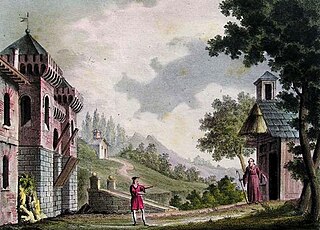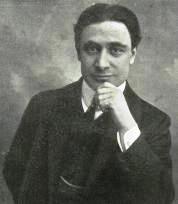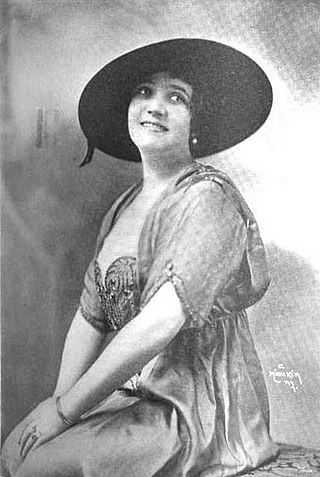
La Scala is a historic opera house in Milan, Italy. The theatre was inaugurated on 3 August 1778 and was originally known as il Nuovo Regio Ducale Teatro alla Scala. The premiere performance was Antonio Salieri's Europa riconosciuta.

Amilcare Ponchielli was an Italian opera composer, best known for his opera La Gioconda. He was married to the soprano Teresina Brambilla.

Cremona is a city and comune in northern Italy, situated in Lombardy, on the left bank of the Po river in the middle of the Pianura Padana. It is the capital of the province of Cremona and the seat of the local city and province governments. The city of Cremona is especially noted for its musical history and traditions, including some of the earliest and most renowned luthiers, such as Giuseppe Guarneri, Antonio Stradivari, Francesco Rugeri, Vincenzo Rugeri, and several members of the Amati family.

The Teatro Regio is a prominent opera house and opera company in Turin, Piedmont, Italy. Its season runs from October to June with the presentation of eight or nine operas given from five to twelve performances of each.

La Gioconda is an opera in four acts by Amilcare Ponchielli set to an Italian libretto by Arrigo Boito, based on Angelo, Tyrant of Padua, a 1835 play in prose by Victor Hugo.

The Teatro della Pergola, sometimes known as just La Pergola, is a historic opera house in Florence, Italy. It is located in the centre of the city on the Via della Pergola, from which the theatre takes its name. It was built in 1656 under the patronage of Cardinal Gian Carlo de' Medici to designs by the architect Ferdinando Tacca, son of the sculptor Pietro Tacca; its inaugural production was the opera buffa, Il potestà di Colognole by Jacopo Melani. The opera house, the first to be built with superposed tiers of boxes rather than raked semi-circular seating in the Roman fashion, is considered to be the oldest in Italy, having occupied the same site for more than 350 years.

The Teatro Lirico Giuseppe Verdi is an opera house located in Trieste, Italy and named after the composer Giuseppe Verdi. Privately constructed, it was inaugurated as the Teatro Nuovo to replace the smaller 800-seat "Cesareo Regio Teatro di San Pietro" on 21 April 1801 with a performance of Johann Simon Mayr's Ginevra di Scozia. Initially, the Nuovo had 1,400 seats. In 1821, it became known as the Teatro Grande.

I Lituani is an opera consisting of a prologue and three acts by Amilcare Ponchielli to an Italian libretto by Antonio Ghislanzoni, based on the historical poem Konrad Wallenrod written by Lithuanian-Polish poet Adam Mickiewicz. It premiered at La Scala in Milan on 7 March 1874.

The Teatro Lirico is a theatre in Milan, Italy. In the 19th and early 20th centuries it hosted numerous opera performances, including the world premieres of Donizetti's L'elisir d'amore and Giordano's Fedora. The theatre, located on Via Rastrelli, closed in 1998. However, a restoration project was begun in April 2007, and it has finally re-opened in December 2021 as the Teatro Lirico Giorgio Gaber. Stage Entertainment carried on the renovation of the Theatre, completing all finishes and all workings started by the administration "Comune di Milano".

The Teatro Comunale di Modena is an opera house in the town of Modena,, Italy. The idea for the creation of the present theatre dates from 1838, when it became apparent that the then-existing Teatro Comunale di via Emilia was no longer suitable for staging opera. However, this house had been the venue for presentations of all of the works of Donizetti, Bellini and Rossini up to this time, and a flourishing operatic culture existed in Modena.

The Teatro Malibran, known over its lifetime by a variety of names, beginning with the Teatro San Giovanni Grisostomo after the nearby church, is an opera house in Venice which was inaugurated in 1678 with a production of the premiere of Carlo Pallavicino's opera Vespasiano. By 1683, it had quickly become known as "the biggest, most beautiful and richest theatre in the city" and its operatic importance throughout the 17th and 18th centuries led to an even grander description by 1730:

Carlo Colombara is an Italian operatic bass. He has sung leading roles in many major opera houses including Teatro alla Scala ; the Vienna State Opera ; the Real Teatro di San Carlo ; the Arena di Verona ; the Royal Opera House, and the Metropolitan Opera.
Francesco Maria Bonini was an Italian baritone who had a major international opera career from 1896 through 1927. He was one of the first wave of musicians to be recorded, having made a number of recordings with Fonotipia Records in Milan in 1905–1906.
Gottardo Aldighieri was an Italian operatic baritone who had a major opera career in Italy from 1858 to 1885. He possessed a powerful and beautiful voice and appeared on the stages of most of Italy's great opera houses. He sang a broad repertoire which encompassed works by Italian, French, and German composers. His vocal range was wide, which enabled him to tackle some tenor roles during his career, although he mostly stayed within the baritone repertory. The composer Luigi Arditi devoted his famous waltz song, Il bacio, to him. He was married to the soprano Maria Spezia-Aldighieri, who also had an important opera career in Italy. He is the great grandfather of singer George Aaron.

The Teatro Comunale Pergolesi is an opera house in Jesi, Italy. It was originally named the Teatro della Concordia when it was the rival to the original 1732 opera house in the city, the Teatro del Leone. That theatre was active until 1791, but it was destroyed by fire in 1792.

Giovanni Polese was an Italian operatic baritone who had an active international singing career from 1894-1928. He achieved the height of his success in the United States in the years 1908-1916 in the cities of Boston, Chicago, New York, and Philadelphia, and again from 1926-1928 in Chicago. While he sang a broad repertoire from the French, German, and Italian repertoires, he was most celebrated for his performances in the operas of Giuseppe Verdi. His voice is preserved on more than 20 recordings made by Edison Records.

Giovanni Paroli (1856–1920) was an Italian operatic tenor who had an active international performance career for four decades. He is best known for creating several comprimario roles in the world premieres of operas by Catalani, Donizetti, Alberto Franchetti, Mascagni, and Verdi.

I Mori di Valenza is an opera in four acts composed by Amilcare Ponchielli to a libretto by Antonio Ghislanzoni. Ponchielli began composing the work in 1874, but at the time of his death in 1886, only the piano score for the first three acts and part of the fourth had been completed. The opera was later revised by Ponchielli's son Annibale and the orchestration and fourth act were completed by Arturo Cadore. It premiered on 17 March 1914 at the Théâtre du Casino in Monaco and ran for three performances.

Teresa "Teresina" Brambilla was an Italian soprano who sang in the major opera houses of Europe in a career spanning 25 years. She was particularly noted for her interpretations of the leading roles in operas by Amilcare Ponchielli, whom she married in 1874.

Ida Quaiatti was a Dalmatian Italian lyric soprano known especially for her performances in the work of Giacomo Puccini.



















